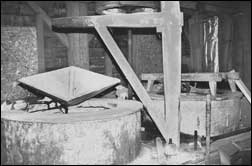
PHOTO
BY LAUREN HEATON
Milling equipment still remains inside the abandoned Grinnell
Mill.
|
|
No
options left, Antioch vice chancellor says—
Time
runs out for Grinnell Mill
Grinnell Mill, which
stood on the Little Miami River in the South Glen for 200 years, will
likely be dismantled or razed.
Facing an Oct. 6
deadline from Miami Township Fire-Rescue to come up with a plan to rehab
or sell the mill, Antioch University was unable to find a way to salvage
the historic structure, whose white oak frame hewn by ax from local timber
still stands as straight and solid as it always has through the fires,
floods and all manner of natural and human disaster the mill has endured
since it was built in the early 1800s.
Now there are no
options left, Antioch University Vice Chancellor Glenn Watts said on Monday.
Barring a miracle,
Watts said that he plans to move expeditiously to advertise to seek groups
or individuals that may be interested in dismantling the mill and moving
it or salvaging its lumber. The process should take between a month and
six weeks, he said.
If there is no response,
Grinnell Mill will be razed. “This thing is on a course,”
he said.
In June, the Miami
Township fire department declared the mill a fire and safety hazard and
gave Antioch 90 days to find a way to save the building. The department
then gave Antioch an extension until Oct. 6, which the university was
unable to take advantage of.
Antioch does not
have the funds to restore the building and was trying to reach an agreement
with at least one local resident to rehab the mill.
That resident, Jim
Hammond, has the interest, skill and financial ability to restore it but
was also not able to negotiate a satisfactory lease or purchase deal with
Antioch.
The Yellow Springs
Historical Society recently considered buying the mill, but the organization’s
board decided in mid-September that it was not in a position to manage
property.
The Glen Helen Board
of Overseers asked to be included in negotiations with Hammond over a
year ago, but, according to its president, David Hergesheimer, the board
was told by Bob Whyte, the executive director of the Glen Helen Ecology
Institute, that “the college would handle it.”
Whyte said that he
thinks the college has put forth a good faith effort and that if the mill
is a community resource, then the community needed to contribute to the
effort to save it.
The Glen Helen Association
chose not to get involved in the matter, the association’s vice
president, Kathy Reed, said.
Local residents with
varying connections to the mill, such as Milt Lord, Richard Hunt, Dan
Rudolf and David Huber, all said recently that they wanted to see the
mill restored decades ago but have seen little to no progress toward that
end. Now they want the issue resolved, they say, even if it means that
the mill is destroyed.
The mill has faced
adversity since it was first constructed. According to the application
making Grinnell Mill and its surrounds an historic district, the mill
burned down just after Robert and Andrew Moody built it as a gristmill
around 1812.
When it was reconstructed,
probably in the 1820s, its builders squared off whole tree trunks and
fitted them together for framing, studs, joists and rafters with a pre-Civil
War scribe rule layout, cutting Roman numeral marriage marks into the
wood where the pieces fit together.
The water-powered
Moody mill turned two large grinding stones on the first floor to pulverize
wheat into flour for early Yellow Springs residents and travelers on the
Xenia-Springfield stage road that ran beside it. Its pulleys, cranks and
shafts extended from the basement to the third floor to process materials
when Matthew Corry owned the mill in 1862, the year Moncure Conway used
it to shelter a band of former slaves he helped bring to Yellow Springs
until permanent housing could be found for them.
Frank Grinnell and
his family bought the mill that same year, named it Spring Lea Mill and
continued to operate it as a grist and limestone mill for another 75 years.
The mill was again
damaged during the flood of 1913, after which a Leffel turbine was installed
to replace the wheel. When the mill stopped operating for good in 1937,
it was abandoned for a decade before Antioch College acquired it as part
of Glen Helen.
It held up through
several subsequent tenants and remodelling efforts, as well as a red paint
job in the 1960s and a good 50 years of vandals who continued as recently
as last week to break in and trash the structure.
The mill’s
post and beam frame may still be sturdy, but the wood shake roof is leaking,
the limestone foundation needs securing and the wooden floorboards and
side panels are wearing. As light peeks through cracks and holes in the
walls, and termites and raccoons impose their will, the natural elements
of the forest begin to reclaim what the mill took from them so long ago
that no one alive can remember it.
If they have been
listening, they know that they are likely to get their land back in short
order.
—Lauren
Heaton
|



